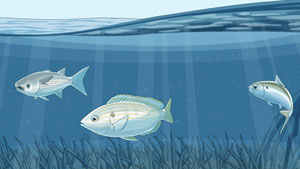The ABCs of Ecosystem-Based Fisheries Management—Part IV
Protecting essential fish habitat: Homes and nurseries
On May 29, the House Natural Resources Committee met to refine legislation reauthorizing and amending the Magnuson-Stevens Fishery Conservation and Management Act, the primary law that governs fishing in U.S. ocean waters. This is vital work: Our oceans are one of our nation’s most valuable natural resources. And congressional leaders should capitalize on this opportunity by adding stronger protections for essential habitat that fish populations need to spawn and grow in a healthy marine ecosystem.
Since the Magnuson-Stevens Act was originally enacted in 1976, scientific research has greatly increased our understanding of how the world’s oceans work. We now also have more accurate information about the effects of human activities onthe health of marine ecosystems.
For example, scientists have found that fishing practices such as bottom trawling or dredging can destroy essential, fragile wildlife habitat on the ocean’s floor in a single pass. Research also has demonstrated that industrial pollution and agricultural runoff can damage nearshore and brackish estuarine habitats that serve as important nurseries for countless species of ocean fish. The massive seasonal dead zones documented in the Gulf of Mexico and Chesapeake Bay are just two examples of how our actions on land can have devastating results in the water.
New research on our oceans, however, also provides a way forward. And the science is clear on the ecological and economic benefits of habitat protection—an integral element of effective ecosystem-based fisheries management.
Adequate amounts of productive habitats are critical to the development of vibrant marine ecosystems capable of supporting healthy fish populations, just as they are for animals on land. Rich collections of deep-sea corals off the coast of Alaska, for example, serve as a safe harbor from harsh ocean currents—providing necessary areas for fish to spawn, feed, and take shelter from predators. These sites are home to an array of marine species—including Pacific ocean perch, rockfish, and crabs. In fact, a study on the linkages between corals and fish populations by the North Pacific Research Board’s Science Program found that “64-72% of commercially important fish species in the Aleutians were associated with corals or sponges.”
Several regional fishery management councils have moved ahead with forward-thinking plans to protect essential fish habitat. For example, in 2005 the North Pacific Fishery Management Council made a landmark decision to safeguard deep-sea corals from destructive bottom trawling in roughly 280,000 square nautical miles of ocean waters around the Aleutian Islands off the Alaskan coast—an area nearly twice the size of California. Yet, despite this step and other proactive regional efforts, national protection of fishery habitat remains uneven.
The Magnuson-Stevens Act was amended in 1996 to require the National Oceanic and Atmospheric Administration’s Fisheries Service, or NOAA Fisheries, and regional fishery management councils to describe, identify, protect, and enhance essential fish habitats “to the extent practicable.” However, undertaking specific actions to protect habitat, such as banning certain fishing gear types in sensitive areas, can often be deemed “impracticable” by regional officials. Federal fishery managers also have designated large swaths of ocean as essential fish habitat, but they have failed to follow through on protective measures by subsequently deciding that proposed enforcement tools were impracticable because of the size of the designated habitat. This practice must end.
As the legislative process for reauthorizing the Magnuson-Stevens Act progresses, congressional leaders should include language to:
- Require federal agencies that fund, undertake, or authorize activities affecting the health of marine ecosystems to minimize the activities that have the potential to damage essential fish habitats.
- Enhance current legal tools available to federal fisheries managers to protect “habitat areas of particular concern.”
- Require regional fishery management councils to designate and protect deep-sea corals.
By using the scientific resources available today, it’s possible to design highly targeted policies that balance potential short-term impacts on fishermen with the longer-term goal of creating safe areas for fish to live and spawn. And by establishing national policies that focus on overall health of marine ecosystems, including adequate and robust habitats, Congress can in turn ensure that Americans have plenty of fish to catch, both for food and sport, for decades to come.
Read the article at newswatch.nationalgeographic.com.







